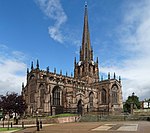The Rotherham child sexual exploitation scandal consists of the organised child sexual abuse that occurred in the town of Rotherham, South Yorkshire, Northern England from the late 1980s until 2013 and the failure of local authorities to act on reports of the abuse throughout most of that period. Researcher Angie Heal, who was hired by local officials and warned them about child exploitation occurring between 2002 and 2007, has since described it as the "biggest child protection scandal in UK history", with one report estimating that 1,400 girls were abused by "grooming gangs". Evidence of the abuse was first noted in the early 1990s, when care home managers investigated reports that children in their care were being picked up by taxi drivers. From at least 2001, multiple reports passed names of alleged perpetrators, several from one family, to the police and Rotherham Council. The first group conviction took place in 2010, when five British-Pakistani men were convicted of sexual offences against girls aged 12–16. From January 2011 Andrew Norfolk of The Times pressed the issue, reporting in 2012 that the abuse in the town was widespread and that the police and council had known about it for over ten years.The Times articles, along with the 2012 trial of the Rochdale child sex abuse ring, prompted the House of Commons Home Affairs Committee to conduct hearings. Following this and further articles from Norfolk, Rotherham Council commissioned an independent inquiry led by Professor Alexis Jay. In August 2014 the Jay report concluded that an estimated 1,400 children had been sexually abused in Rotherham between 1997 and 2013, predominantly by British-Pakistani men. The victims were ethnically diverse; with British Asian girls in Rotherham also suffering, despite the claim that the victims were only white. Social isolation and fear of dishonour prevented Asian victims from coming forward.BBC News (29 August 2014): "A care worker, who worked at children's homes from 2003–2007, told the BBC men would arrive almost 'every night' to collect girls, who escaped using a range of methods and were then usually driven off in taxis."}} The abuse included gang rape, forcing children to watch rape, dousing them with petrol and threatening to set them on fire, threatening to rape their mothers and younger sisters, as well as trafficking them to other towns. There were pregnancies (one at age 12), pregnancy terminations, miscarriages, babies raised by their mothers, in addition to babies removed, causing further trauma.The failure to address the abuse was attributed to a combination of factors revolving around race, class, religion and gender—fear that the perpetrators' ethnicity would trigger allegations of racism; contemptuous and sexist attitudes toward the mostly working-class victims; lack of a child-centred focus; a desire to protect the town's reputation; and lack of training and resources.Rotherham Council's chief executive, its director of children's services, as well as the Police and Crime Commissioner for South Yorkshire Police all resigned. The Independent Police Complaints Commission and the National Crime Agency both opened inquiries, the latter expected to last eight years. The government appointed Louise Casey to conduct an inspection of Rotherham Council. Published in January 2015, the Casey report concluded that the council had a bullying, sexist culture of covering up information and silencing whistleblowers; it was "not fit for purpose". In February 2015 the government replaced the council's elected officers with a team of five commissioners. As a result of new police inquiries, 19 men and two women were convicted in 2016 and 2017 of sexual offences in the town dating back to the late 1980s; one of the ringleaders was jailed for 35 years.









